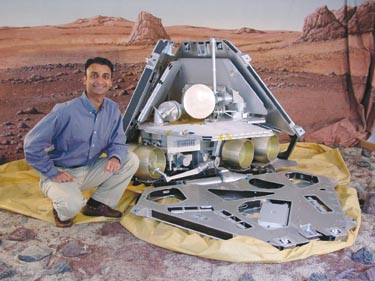NRI, Prasun Desai ( part of 50-member team) was responsible for the entry and landing on the twin rovers on Mars.

As the world watched, the Mars Exploration Rovers undertook detective work on the red planet, guided by computer software developed by a National Aeronautics and Space Administration (NASA) team lead by Kanna Rajan.
And the team responsible for the entry and landing of the twin rovers, Spirit and Opportunity, is also headed by an Indian American, Prasun N. Desai.Desai, an aerospace engineer at NASA’s Langley Research Center, Va, who led the team which supported the Jet Propulsion Laboratory, explains: “The system that we contributed to was the entry, descent and landing system for MER, determining how we bring this Lander safely down; It was just a completely amazing experience — putting a system like this together to make it successful trying to land on another planet.”
"Scores of calculations, trajectory of the spacecraft, parachute design, sequence of events and all our study in aerospace had to be coordinated accurately to ensure that the spaceship enters Mars hemisphere slowly as it was travelling at a speed of around 22,000 km per hour and we had to bring it down to zero," the scientist who is completing his PHD in aerospace studies from University of Illinois said.
As the spacecraft approached Mars, Desai and his colleagues began work at about 9 a.m. that Saturday morning in the EDL War Room. The initials stand for "entry, descent and landing," the crucial steps for changing the spacecraft Spirit from an interplanetary space cruiser to a six-wheeled robot equipped to roll over Martian terrain in search for signs of life and water.
Well before the historic event, Desai admitted that the success or failure of the mission would boil down to the last six minutes, the period when Spirit's parachutes would be deployed and its rockets fired to slow it down for landing on Mars.
"Three and a half years of work comes down to the last six minutes," said Desai, who watched the landing from mission control at NASA's Jet Propulsion Lab.
He said it took the signal from their station on earth 10 minutes to reach the spacecraft, which took six minutes to land after entering Mars hemisphere, so it had already landed on the red planet by the time the signal reached during landing.
NRI at NASA aims at Sun after Mars project
Prasun Desai
Aerospace Engineer
NASA Langley Research Center
Hampton, Virginia
United States Of America
Education
- High School: Johnathan Dayton High School, Sprinfield, NJ
- B.S. in Mechanical Engineering, Rutgers University
- M.S. in Astronautics, George Washingtong University
- PhD. in Aeronautical and Astronautical Engineering, University of
Illinois
Contributions to Mars Exploration
I perform flight dynamic and systems analysis for the entry, descent, and landing of the rovers. [more..]
2003 Mars Exploration Rover Mission